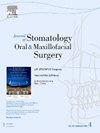Feasibility of augmented reality combine patient-specific implants (PSI) applied to navigation in mandibular genioplasty: A phantom experiment
IF 1.8
3区 医学
Q2 DENTISTRY, ORAL SURGERY & MEDICINE
Journal of Stomatology Oral and Maxillofacial Surgery
Pub Date : 2025-02-01
DOI:10.1016/j.jormas.2024.102039
引用次数: 0
Abstract
Purpose: Genitoplasty is becoming more and more common, and it is important to improve the accuracy of the procedure and simplify the procedure. This experiment explores the feasibility of using augmented reality (AR) technology combined with PSI titanium plates for navigational assistance in genioplasty performed on models, aiming to study the precision of such surgical interventions.
Methods: Twelve genioplasty procedures were designed and implemented on 3D-printed resin mandibular models by the same surgeon using three different approaches: AR+3DT group (AR+PSI) , 3DT group (patient-specific titanium plate) , and a traditional free-hand group(FH group). Postoperative models were assessed using CBCT to evaluate surgical accuracy.
Results: In terms of osteotomy accuracy, the AR group demonstrated a surgical error of 0.9440±0.5441 mm, significantly lower than the control group, which had an error of 1.685±0.8907 mm (P < 0.0001). In experiments positioning the distal segment of the chin, the overall centroid shift in the AR group was 0.3661±0.1360 mm, significantly less than the 2.304±0.9629 mm in the 3DT group and 1.562±0.9799 mm in the FH group (P < 0.0001). Regarding angular error, the AR+3DT group showed 2.825±1.373°, significantly <8.283±3.640° in the 3DT group and 7.234±5.241° in the FH group.
Conclusion: AR navigation technology combined with PSI titanium plates demonstrates higher surgical accuracy compared to traditional methods and shows feasibility for use. Further validation through clinical trials is necessary.
将增强现实技术与患者特异性植入体(PSI)结合应用于下颌骨成形术导航的可行性:模拟实验。
目的:生殖器成形术越来越常见,因此提高手术的精确度并简化手术过程非常重要。本实验探讨了使用增强现实(AR)技术结合 PSI 钛板为在模型上进行的基因成形术提供导航辅助的可行性,旨在研究此类手术干预的精确性:由同一外科医生采用三种不同的方法,在三维打印的树脂下颌骨模型上设计并实施了 12 例牙根成形术:AR+3DT组(AR+PSI)、3DT组(患者特异性钛板)和传统徒手组(FH组)。使用 CBCT 对术后模型进行评估,以评价手术的准确性:结果:在截骨准确性方面,AR 组的手术误差为 0.9440±0.5441 mm,明显低于对照组的 1.685±0.8907 mm(PC结论:AR 导航技术结合 PSI 钛板,可显著提高截骨准确性:与传统方法相比,AR 导航技术结合 PSI 钛板显示出更高的手术准确性,并显示出使用的可行性。有必要通过临床试验进行进一步验证。
本文章由计算机程序翻译,如有差异,请以英文原文为准。
求助全文
约1分钟内获得全文
求助全文
来源期刊

Journal of Stomatology Oral and Maxillofacial Surgery
Surgery, Dentistry, Oral Surgery and Medicine, Otorhinolaryngology and Facial Plastic Surgery
CiteScore
2.30
自引率
9.10%
发文量
0
审稿时长
23 days
 求助内容:
求助内容: 应助结果提醒方式:
应助结果提醒方式:


